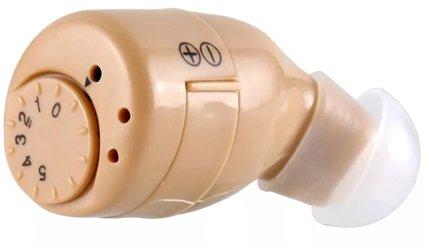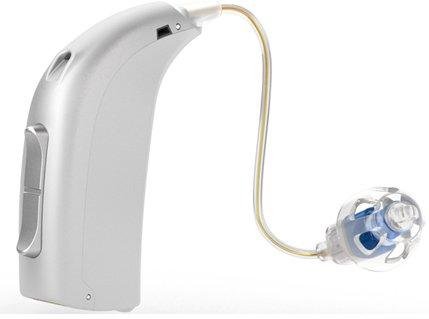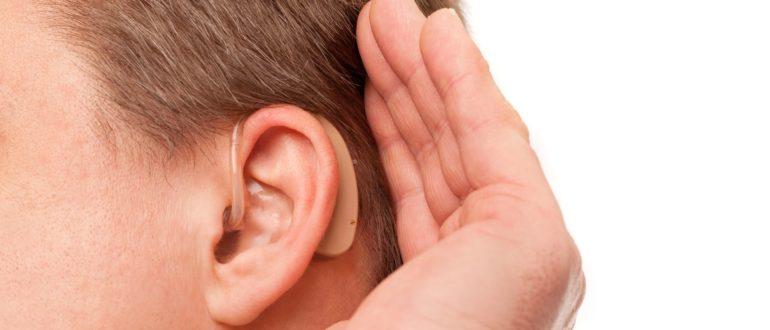The ability to hear and listen is an important part of people's habitual communication and orientation in life. Unfortunately, according to world statistics, about 10% of people have hearing problems. Such a violation causes a lot of discomfort, and can also cause a general deterioration in health and normal progress in society. Many people get used to it, but thanks to modern technology and progress in general, there is a way out - hearing aids. With its help, it is possible to optimize the level of residual hearing, as well as improve the quality of life throughout. The doctor should indicate specific types and models, but there are situations in which you can do without his help, in which case you need to know how to choose a hearing aid, what to look for when buying.
Content
The principle of operation and design of hearing aids
Hearing aids are understood by many people to be large devices. Modern developments and the work of physicians have made it possible to make special equipment, which is not only minimal in size, but also very effective. Some people around may not even see the presence of the apparatus in a person with poor hearing.
The smallest ones can be about the same as coffee beans, and this does not affect the quality of functioning and efficiency. Any hearing aid is a medical device that can amplify external sounds. The technique is used for a variety of hearing impairments to improve people's quality of life if other treatment options fail.
Modern equipment for improving hearing qualities includes the following elements:
- Microphone - allows you to catch sound and transform it into impulse.
- Amplifier - increases the strength of the impulses.
- Speaker - translates impulses into sounds that can be heard by the device carrier.
Among other parts, microcircuits are used for programming, a volume rocker, as well as start and stop keys. The equipment is worn behind the ear or in the ear, it is not a panacea that restores hearing, but with the help of operation, many positive aspects appear.
The main disadvantage of any device is background noise. To combat the problem, some manufacturers make it so that the device itself picks up speech, giving it to the user with maximum noise suppression.
Types of hearing aids
All hearing aids are divided into several types that you should be aware of before purchasing. Based on this, you can make a choice, since each model is characterized by certain features, pros and cons.
In-the-ear devices

These are the smallest and neat types of hearing aids that sit right in the ear. Their body is made individually for a person, since each has certain sizes, shapes and other features of the ear. Based on the manufacturing parameters, the degree of the hearing restoration device is different:
- IIC - suitable for people with minor hearing loss, placement is done deep in the ear.
- CIC - the body is located in the outer part of the ear, recommended for moderate to severe impairment.
- ITC - will visually protrude from the ear.
- HS - protrude more into the ear.
- FS - the device is completely in the ear, it is recommended to use only in case of severe hearing loss.
Pros:
- Other people do not see the presence of the apparatus.
- There are almost no problems with extraneous noise.
- Models are rarely inferior in efficiency to other analogues.
- Recommended for use regardless of age.
- An excellent choice for active people.
Minuses:
- The equipment operates with small batteries, so they have to be changed often, because their capacity is minimal.
- Often, in-ear models are automatic, since their sizes are small, manufacturers simply cannot add more functions, a volume rocker.
- Filters should be changed from time to time.
- The term of use is lower than that of BTE devices.
- It is forbidden to use for perforation of the membrane, otitis media of a chronic type, as well as for some patients who have a non-standard structure of the ear cavity.
Pocket appliances

Pocket options for improving hearing are rarely used, are in minimal demand, since they are considered technically and morally obsolete. Such devices represent a body with basic elements, it is placed in a pocket or other place, there is also a speaker that is inserted into the auricle. Both parts are connected with a cable.
Pocket models may differ in the way they are handled. Among them are digital and analog devices. The former allow you to process sound at different frequencies in order to reduce loud ones and amplify quiet ones. This gives the person maximum comfort. The second option will amplify all sounds that go into the microphone, so some of them can be loud or quiet.
Pros:
- Easy and intuitive controls. The main elements are large, which is great for elderly people with problems not only hearing, but also vision, motor skills, coordination.
- High degree of reliability.
- Excellent protection against damage.
- The lowest cost among other types.
Minuses:
- The technique is visible to other people.
- The dimensions are quite large.
Behind-the-ear devices

A similar technique is located behind the auricle, externally, the apparatus consists of a body, inside which there are the main parts for improving hearing, as well as an earmold, which allows you to hold and conduct sound, there is also a connecting tube.
These models can improve even severely lost hearing. The volume level changes without the need for human participation, but if necessary, the user can independently perform manual settings through the regulator. Some manufacturers in addition offer a remote control with which you can use different modes, made for a specific environment.
Pros:
- The technique is very simple and one of the most reliable to use.
- Hearing can be restored even with significant hearing loss, up to 120 dB.
- You can find inexpensive but high quality models on sale.
- Recommended for patients with diagnosed chronic otitis media.
- Replacing batteries is very rare for work.
The main drawback is in the visual effect, because any person sees such a device.
Hearing aid selection options
Hearing aids can be selected without a doctor if you know the basic parameters that are worth paying attention to.
External characteristics
Each option is characterized by certain pros and cons, there are bans on use or other restrictions, so the visual features of the devices are not so important, it is much more correct to choose the device according to the technical parameters and your own hearing condition.
During operation, the user should not have any discomfort, and the correctly selected earbud eliminates the development of whistling in the air, providing the best quality.
Selecting the type of sound processing
When choosing, it is important to decide on the type of device. Digital models are preferable because they allow the sound to be digitized for higher quality. Each model is highly functional, as well as manufacturers offer additional elements to simplify operation. Analog devices give mediocre sound.
Sound quality
Sound quality makes it possible to determine several parameters at once:
- The frequency of the device. It is recommended to use the bandwidth as wide as possible to obtain clear speech.
- Compression helps to amplify sound of varying strength. Modern devices allow you to make listening to external sounds comfortable.
- Channels. Their number should be large, since the possibility of gain settings depends on the range.
- The locator and its presence helps to enhance speech.
- Power. When buying equipment, you need to understand that you should give preference not only to products that can reproduce sound, their power should be enough to restore violations if there are complications.
- Noise suppression technologies will prove to be an equally useful addition.
Connecting tube
BTE views include a special tube for connecting the earbud and the device itself, due to which it should be moderately long and flexible. If the element is too short, the person will not be able to properly position the earmold in the ear, so a whistle develops. Long tubing may not hold well.
The size of the external auditory canal
If the aisle is narrow, then even CIETs may be visible to other people. In addition, if a wearer needs to recover from severe hearing loss, small hearing aids may not always have the same effect.
additional characteristics
Before buying, be sure to check at the point of sale for the possibility of repair work if the device is broken. Well-known companies often provide a warranty period of 2 years or more. Additional features can be useful, including automatic switching of operating modes, the ability to change the volume, as well as other functions that simplify use and make life more comfortable. The control itself can be carried out using the remote control or on the case.
The setting methods for machines may also differ. It is customary to divide 2 groups, among them a programmable technique, which is adjusted for a specific person and his hearing. During setup, the computer calculates the optimal settings to increase the volume. A person's age and experience with such devices are automatically determined.
The trimming technique will be mechanically tuned by a person. This requires using a screwdriver to rotate the adjuster. Using this method, it is difficult to set the parameters, so the accuracy decreases.
The cost
When understanding how to choose hearing aids, you should consider pricing. The cost can be in a wide range as it is influenced by many factors. Figuratively, products are divided into 5 classes, but every year new models appear, the assortment expands, so the boundaries of prices are erased. Even inexpensive models can include additional features. On average, the price is as follows:
- Budget models that are characterized by manual or software settings, as well as different types of sound processing will cost around 10,000 rubles.
- Middle class devices are in the range of 25-40 thousand rubles. The technique is programmable, there is the possibility of suppressing noise, and also improves speech. Microphone pair technology is often used.
- The best options will be as functional as possible, and are also made personally for a person. Pricing policy starts from 40,000 rubles
How to choose the best hearing aid
When deciding on a technique to improve your hearing, the following expert tips should be considered:
- When choosing a device, it is better to choose among digital models, because they help to make the sound quality higher in comparison with analog ones.
- The external data of the device may not play a significant role, but this is not always the case. For example, in-the-ear options will be an excellent helper for those who are trying to mask their defect as much as possible. In addition to visual parameters, it is also important to take into account the strength of violations, because the described devices cannot restore strong violations. If your hearing loss is significant, it is best to choose BTE.
- If external characteristics are not important, then it will be better to buy behind-the-ear models. In addition, the device does not need constant maintenance, so it is great for the elderly.
Expert advice
There are certain rules that professionals advise to adhere to. They can be divided into those that apply before and after the purchase. Before purchasing a device, you must:
- Check your own hearing with a doctor and take into account the recommendations for a device model for improving the condition, specifically for personal characteristics.
- Places where you plan to buy a device must be licensed to sell these devices. It is not recommended to give preference to unverified companies, since there are risks of buying a fake. In addition, you do not need to believe people who claim that hearing will gradually recover or that the technique can completely remove noise.
- Before starting the payment, you need to find out if there is a possibility of a test period in order to check the device on your own ear and hearing condition. 2-3 days will be enough to determine this. Some points of sale provide the service for free.
- Choose the power with a margin, since over time, hearing will deteriorate, and increasing the volume will be an important factor.
- Any product must have a warranty period.
After a purchase, a person needs time to get used to the device. With the right selection, there will be comfortable operation and wear. In addition, all sounds will be heard well, speech is clear. Even after purchasing a model, there are a few rules:
- The technique cannot normalize hearing, it is only used to increase the volume and remove noise.
- It is permissible to use the device in any place, as well as in an environment that helps train your hearing.
If you can't control the devices right away, don't be upset. The longer the operation, the less attention the user pays to the device, and after a while he does not notice it at all.



